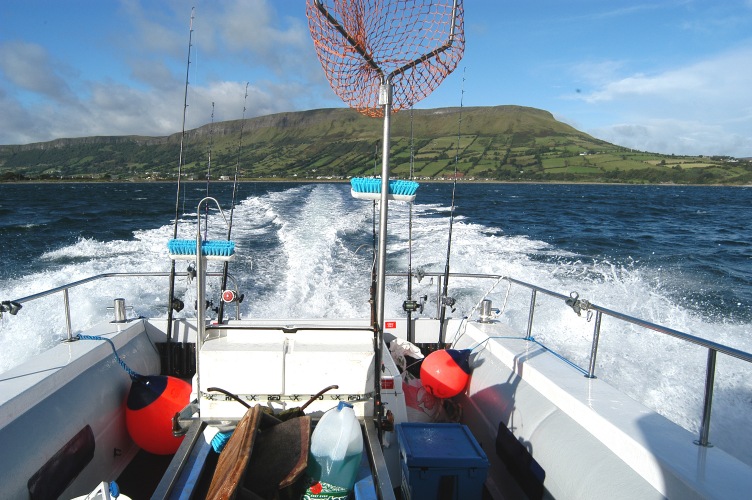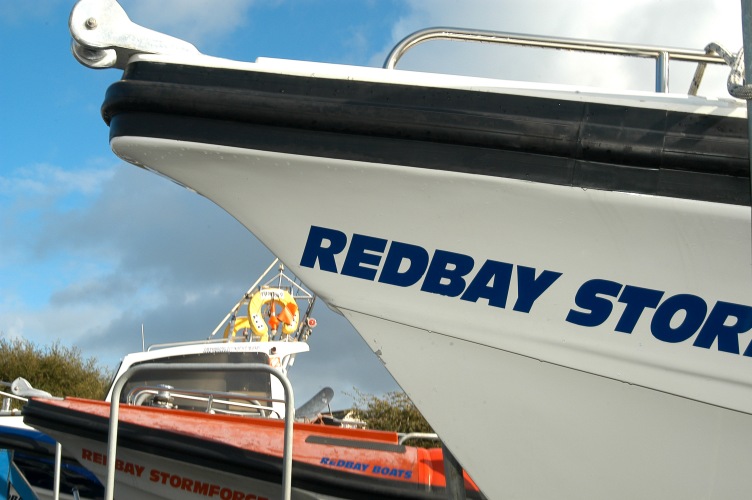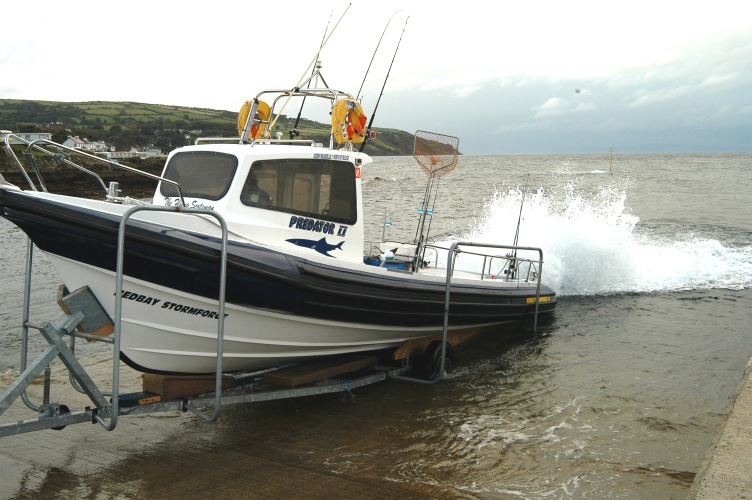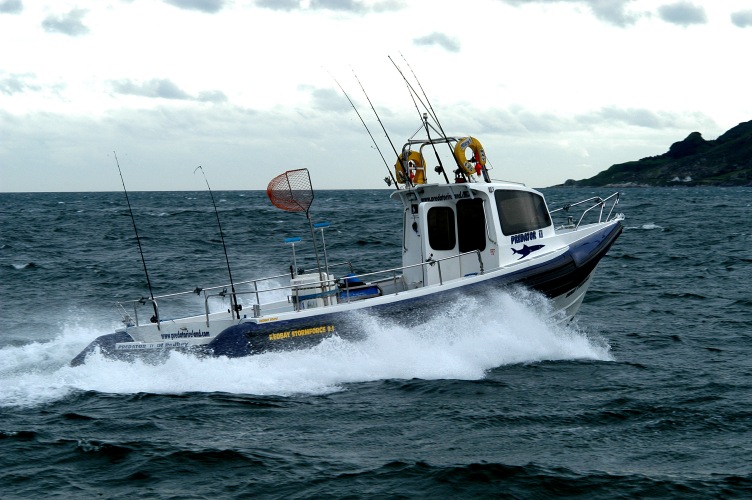Boat Test - Stormforce Charter Rib

In the old testament of The Bible, Genesis Chapter 2 verse 21 tells how in the beginning God took a rib from Adam and set the way clear for the rest of the human population by using it to create Eve. In similar fashion, at Cushendall in Northern Ireland, Red Bay Boats owner Tom McGloughlin took a RIB, in this case from his Stormforce Boats workshop, and set the way clear for a whole new generation of inshore and offshore fishing boats. 'But you canít fish from a RIB' (Rigid Inflatable Boat) is the argument most serious boat anglers come back with when you talk about the practicalities of angling from an inflatable. RIBís are for divers, customs officers, coastguard search and rescue teams and the like. Well you try telling that to Tom McGloughlin and Cushendall charter boat skipper Hamish Currie.
It is precisely because of their pace, comfort, stability and handling properties that divers and the authorities are so keen on the use of RIBís. Why shouldn't anglers be denied those qualities too. 'But what about hooks, filleting knives and gaffs puncturing the tubes causing it to sink?' Well for starters a RIB will not sink on the basis of a single puncture. Each hypalon tube has separate compartments within it, and you would struggle with a fishing hook to penetrate the material these tubes are constructed from anyway, even without the added protection they are given. As for holing it with knives or other sharp objects inside the boat, in the case of Hamish Currieís boat Predator II, that is just not possible as the entire interior is made from glass fibre just like any conventional charter fishing boat.

In effect, what Tom has built for Hamish is a boat within a boat. Even with both tubes totally deflated (which would never happen) you still have a fibre glass boat to stand in. Not ideal I grant you, but it should get you safely back to port. The only way you can tell you are in a RIB when you board Predator II is by the slight curvature along each side as the fibre glass follows the radius of the tube. But you can tell you are in a RIB, or perhaps I should say, you can tell immediately you are not in a traditional glass fibre fishing boat the moment the throttle is pushed forward, particularly in a lumpy sea. For a RIB will give you a ride and performance the likes of which no conventional fishing boat can.
I must hold my hand up and say that I knew nothing about RIBís whatsoever before I visited Northern Ireland. I had seen them occasionally in action over here and was well aware from first hand observations of their pace and handling potential. But RIBís as I knew them were for people like divers and the rescue services dressed in dry suits and expecting to get wet. Why would anglers want treatment like that. Well, the simple answer is that they donít. What anglers do want is security which in short means tall gunnels and transom, comfortable seating, and shelter. Everything that the traditional RIB as seen previously was not. But we are not talking about traditional RIBís at Cushendall. This is a whole new generation of boats, and for my money they are the future of serious offshore angling.
Serious RIBís seem to be a peculiarly Irish thing. You seem them regularly over there. I counted 14 RIBís, the majority of which were in the 9 to 11 metre class in Ballycastle harbour alone. The Irish use them as up market gin palaces; as passenger boats to Scotland fully covered and fitted out with aircraft type seats, and as ferries to nearby Rathlin Island which is separated from Ballycastle by one of the most treacherous pieces of water anywhere on the planet. But letís stick with fishing boat concept. At the time of writing, Predator II is the only purpose built charter angling RIB in the UK and possibly even in the world. But mark my words, it wonít be the last.


Predator II is based a standard 9.1 metre long Stormforce Red Bay RIB. As I said earlier, the entire interior is protected by fibre glass. She has a full cabin not that dissimilar to many conventional 30 foot charter boats, and is powered by a Yamaha 241 inboard diesel engine with a 450 mile operating range. This gives the boat a top speed of 30 knots and a cruising speed of 22 knots. There will be GRP boats on the market that can probably offer a similar specification. I havenít seen these boats put through their paces so I canít comment on how they would perform. What I can say is that when a RIB has a cruising speed of 22 knots, that is what it will cruise at regardless of the conditions. It can also run at top speed regardless of what the elements might conjure up. In the words of the Red Bay advertising blurb, RIBís are perfect for when you must go to sea.

Any fool can open up the throttle in rough weather regardless of whether itís a RIB or a conventional hull. That much is true. The difference between a RIB and a traditional GRP build is that the ride is so much easier. No getting hammered to death crashing through waves. And the stability is out of this world. What happens in that the tubes cushion the energy generated by slamming down waves, and their buoyancy stops the boat rolling laterally as would be the case with a displacement type hull. This allows the V profile of the GRP section to be continued through to the stern, hence the turn of speed and wave cutting potential. Red Bayís range of big RIBís is not called Stormforce for nothing. Tom McGloughlin likens sailing a big RIB to driving a rally car. It is meant to be pushed to the limit. The sticker on the console of his personal 11 metre RIB sums his feelings up perfectly. It reads ĎDrive it as if you have stolen ití.
Unless you have actually seen a big RIB, it's hard to visualise the thing. The picture I had in my mind for a RIB was a large air filled sausage bent completely around a small solid glass fibre hull. In essence that is what most small RIBís and some of the middle range RIBís are. But when you move up to 9 metres and more in length, they tend to go away from that idea, which is known as the soft nose design, to a more traditional solid pointed bow known as the hard nose option. These larger RIBís look like any other traditional designs of boat, but with a tube fitted to each side. Quite a lot of the RIBís I saw over on the Irish side were 11 metres in length, but a 15 metre version is already on the drawing board with even bigger models whispered to be in the planning.
Now letís take the talk back in the other direction. Pit a small RIB against any current model of trailed fishing dinghy over here in the UK, and in terms of sustainable pace, it will leave the full GRP hull for dead. This means a more realistic chance of getting offshore, and more importantly, an even more realistic chance of making it back safely if conditions turn particularly nasty. But until Tom and his team turned their attention to this sectre of the boat market, a more realistic chance of getting cold and wet aboard a boat in which many anglers would not feel catered for. But a purpose built trailable angling dinghy RIB with a cuddy is now available, which at around 19 feet and fitted with a 150 hp outboard will do 38 knots. Again, I know there are full GRP hulls out there of similar size capable of that kind of performance. The difference is that they can only achieve it under optimal sailing conditions. A RIB can if necessary maintain it, or get a damn site closer to it in the kinds of conditions when any sensible angler would want to be back on shore.

Another thing many of the Irish RIBís have in common is that they not only can be, but often are launched from purpose built trailers with side guides so the boat can be driven back on at the end of the day. Tom McGloughlin uses the companyís tractor to launch his 11 metre version. But Hamish Currie manages quite well with nothing more powerful than a standard Isuzu pick up truck, which means that providing all the on road regulations regarding towing are observed, in situations where there is good, sheltered water fishing with launching facilities close enough to reach by road, yet too far to sail to such as for example on one side or other of the Mull of Galloway, then charter fishing opportunities need not be lost theoretically generating more income, which is perhaps as well, as the one noticeable drawback with RIB's when compared to traditional GRP boats is cost. On the other hand, you only get what you pay for, and if you want the best...........